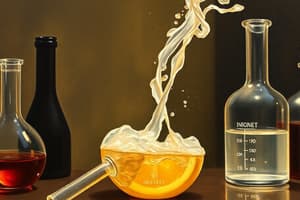Podcast
Questions and Answers
Which statement accurately describes a Bronsted-Lowry acid?
Which statement accurately describes a Bronsted-Lowry acid?
- It donates electrons to a base.
- It accepts a proton from another substance.
- It donates a proton to a base. (correct)
- It remains neutral during a reaction.
In the Bronsted-Lowry theory, what is a base characterized by?
In the Bronsted-Lowry theory, what is a base characterized by?
- A substance that increases the concentration of hydroxide ions in solution.
- A substance that donates electrons to the surrounding environment.
- A substance that has no effect on the solution's acidity.
- A substance that accepts a proton from an acid. (correct)
Which of the following pairs is an example of a Bronsted-Lowry acid-base reaction?
Which of the following pairs is an example of a Bronsted-Lowry acid-base reaction?
- NH3 + H2O ⇌ NH4+ + OH− (correct)
- H2 + Cl2 → 2HCl
- CaCO3 + H2SO4 → CaSO4 + H2O + CO2
- NaOH + HCl → NaCl + H2O
What happens during the ionization of a Bronsted-Lowry acid in water?
What happens during the ionization of a Bronsted-Lowry acid in water?
What is the conjugate base of the strong acid hydrochloric acid (HCl)?
What is the conjugate base of the strong acid hydrochloric acid (HCl)?
Flashcards are hidden until you start studying
Study Notes
Bronsted-Lowry Acids
- A Bronsted-Lowry acid is a substance that donates a proton (H+)
- A proton is the nucleus of a hydrogen atom, which consists of a single positively charged particle
Bronsted-Lowry Bases
- A Bronsted-Lowry base is a substance that accepts a proton (H+)
Bronsted-Lowry Acid-Base Reactions
- In a Bronsted-Lowry acid-base reaction, a proton is transferred from an acid to a base
- The acid loses a proton and becomes its conjugate base
- The base gains a proton and becomes its conjugate acid
- Example of a Bronsted-Lowry acid-base reaction: HCl (acid) + H2O (base) -> H3O+ (conjugate acid) + Cl- (conjugate base)
Ionization of Bronsted-Lowry Acids in Water
- When a Bronsted-Lowry acid ionizes in water, it donates a proton to a water molecule
- The water molecule acts as a base and accepts the proton, forming the hydronium ion (H3O+)
Conjugate Base of Hydrochloric Acid
- The conjugate base of hydrochloric acid (HCl) is chloride ion (Cl-)
- When HCl acts as a Bronsted-Lowry acid, it donates a proton (H+), leaving behind the chloride ion (Cl-)
Studying That Suits You
Use AI to generate personalized quizzes and flashcards to suit your learning preferences.




